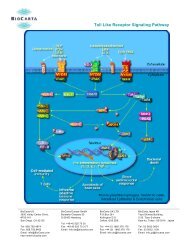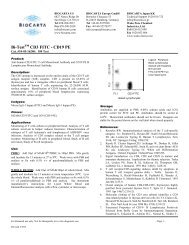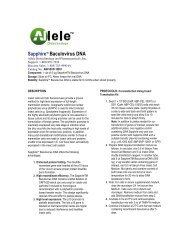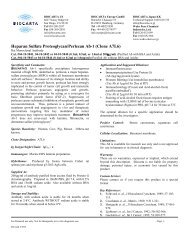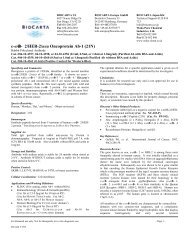View - BioCarta
View - BioCarta
View - BioCarta
You also want an ePaper? Increase the reach of your titles
YUMPU automatically turns print PDFs into web optimized ePapers that Google loves.
SUMMARY and EXPLANATION<br />
This test allows the quantitative flow cytometric determination of the chemotactic function of neutrophilic granulocytes. In analogy to the<br />
Boyden chamber technique, this kit contains multiwell plates and precoated cell culture inserts for chemotaxis studies, the chemotactic peptide<br />
N-formyl-Met-Leu-Phe (fMLP), an antibody reagent, counting beads and necessary reagents. It allows determination of the number of<br />
neutrophils which have migrated through cell culture inserts towards a concentration gradient of the chemoattractant fMLP. Also, the decrease<br />
of expresssion of the cell adhesion molecule LECAM-1 can be analysed together with the shape-change of the cells by analysing the changes of<br />
the forward scatter signals.<br />
The detailed instructions result from specific experience and precise validation assays. Critical steps and hints are in bold letters.<br />
APPLICATIONS<br />
By MIGRATEST ® it is intended to investigate the chemotactic function of neutrophils and to evaluate the effects of drugs on this process.<br />
This kit will allow the investigation of neutrophil chemotaxis in a variety of clinical disorders including: Leukocyte Adhesion Deficiency,<br />
Hyperimmunoglobulin E or Job’s syndrome and Chédiak-Higashi syndrome (CHS) (3-7). Other areas where chemotaxis has been observed to<br />
be altered include patients with renal failure, diabetes, Hodgkin's Disease and arthritis patients with high levels of circulatory immune<br />
complexes (8-10).<br />
Various drugs and immunomodulators can enhance or decrease the chemotactic activity of granulocytes. These effects can be investigated<br />
in vitro or ex vivo with MIGRATEST ® .<br />
TEST PRINCIPLES<br />
The phagocytic process can be separated into several major stages: Chemotaxis as the initiating step of phagocytosis (migration of phagocytes<br />
to inflammatory sites following a gradient of chemotactic factors), attachment of particles to the cell surface of phagocytes, ingestion<br />
(phagocytosis) and intracellular killing by oxygen-dependent and oxygen-independent mechanisms (1, 2). Phagocytosis by polymorphonuclear<br />
neutrophils and monocytes therefore constitutes an essential arm of host defense against bacterial or fungal infections.<br />
MIGRATEST ® allows the quantitative determination of neutrophil chemotaxis. The number of cells which have migrated through cell culture<br />
inserts with a pore size of 3.0 µm towards a concentration gradient of the chemoattractant fMLP can be determined . In parallel, the decrease of<br />
LECAM-1 (11) expression can be measured. Downregulation of this cell adhesion molecule correlates directly with the activation of neutrophils<br />
exposed to chemotactic factors. The shape-change of the cells precedes the cell migration and can be measured by analysing the changes of the<br />
forward scatter signals using flow cytometry. The test kit contains the chemoattractant fMLP, cell culture inserts and necessary reagents.<br />
Leukocytes are isolated from heparinzed whole blood by spontaneous sedimenation over leukocyte SEPARATION MEDIUM and placed into<br />
cell culture inserts. Chemotaxis is conducted at 37°C towards a gradient of fMLP in comparison to a control of INCUBATION BUFFER. The<br />
cells are then stained with an antibody reagent (STAINING/COUNTING REAGENT) which also contains counting beads. Just prior flow<br />
cytometric analysis a special vital DNA dye is added.<br />
In summary, chemotaxis is the initiating step of the multistep and multifactorial process of phagocytosis (1, 2). The whole cascade of events can<br />
be investigated individually under controlled conditions by separate assays: MIGRATEST ® to measure chemotaxis, PHAGOTEST ® to measure<br />
ingestion of bacteria, BURSTTEST (PHAGOBURST ® ) to measure oxidative burst.<br />
MATERIAL and REAGENTS<br />
The test kit contains:<br />
1. 24 specially treated CELL CULTURE INSERTS (3.0 µm pore size), pre-loaded two 24-well dishes.<br />
2. 12 vials (1 ml) containing leukocyte SEPARATION MEDIUM for isolation of leukocyte-rich plasma (LRP).<br />
3. 1 vial (100 µl) containing the chemotactic peptide fMLP (200 x stock solution, 10 µM). Dilute 5 µl in 1 ml of INCUBATION BUFFER<br />
for use.<br />
4. 1 bottle (0.5 ml) antibody and counting reagent (STAINING/COUNTING REAGENT), contains one monoclonal antibody: anti-<br />
LECAM-1-FITC and counting beads.<br />
5. 1 vial (20 ml) containing INCUBATION BUFFER.<br />
6. 1 vial (100 µl) containing vital DNA STAINING SOLUTION. Dilute 5 µl in 250 µl ml of INCUBATION BUFFER for use.<br />
The test kit does not contain the following materials required for the assay:<br />
1. Blood collection tubes containing heparin anticoagulant.<br />
2. 1 or 2 ml disposable test tubes (e.g., Eppendorf, #0030 102.002 or Nunc, #341173).<br />
3. 12 x 75 mm disposable test tubes (Falcon, Becton Dickinson No. #352052) and appropriate test tube racks.<br />
4. Ice bath with cover.<br />
Required apparatus:<br />
1. Variable volume micropipettes 20 - 200 µl, 100 - 1000 µl and disposable tips.<br />
2. Dispenser pipette and dispenser tips.<br />
3. Waterbath.<br />
4. Digital thermometer.<br />
5. Vortex mixer.<br />
6. Flow cytometer with 488 nm excitation wavelength (argon-ion laser).<br />
For reseach use only. Not for therapeutic or in vitro diagnostic use. Page - 1 -<br />
Revised 6/02



